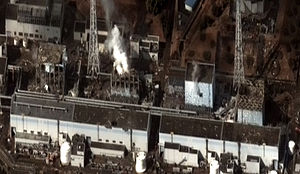

| Part of a series on |
| Pollution |
|---|
 |
Radioactive contamination, also called radiological pollution, is the deposition of, or presence of radioactive substances on surfaces or within solids, liquids, or gases (including the human body), where their presence is unintended or undesirable (from the International Atomic Energy Agency (IAEA) definition).[3]
Such contamination presents a hazard because the radioactive decay of the contaminants produces ionizing radiation (namely alpha, beta, gamma rays and free neutrons). The degree of hazard is determined by the concentration of the contaminants, the energy of the radiation being emitted, the type of radiation, and the proximity of the contamination to organs of the body. It is important to be clear that the contamination gives rise to the radiation hazard, and the terms "radiation" and "contamination" are not interchangeable.
The sources of radioactive pollution can be classified into two groups: natural and man-made. Following an atmospheric nuclear weapon discharge or a nuclear reactor containment breach, the air, soil, people, plants, and animals in the vicinity will become contaminated by nuclear fuel and fission products. A spilled vial of radioactive material like uranyl nitrate may contaminate the floor and any rags used to wipe up the spill. Cases of widespread radioactive contamination include the Bikini Atoll, the Rocky Flats Plant in Colorado, the area near the Fukushima Daiichi nuclear disaster, the area near the Chernobyl disaster, and the area near the Mayak disaster.
- ^ Richard Schiffman (12 March 2013). "Two years on, America hasn't learned lessons of Fukushima nuclear disaster". The Guardian.
- ^ Martin Fackler (June 1, 2011). "Report Finds Japan Underestimated Tsunami Danger". The New York Times.
- ^ International Atomic Energy Agency (2007). IAEA Safety Glossary: Terminology Used in Nuclear Safety and Radiation Protection (PDF). Vienna: IAEA. ISBN 978-92-0-100707-0.